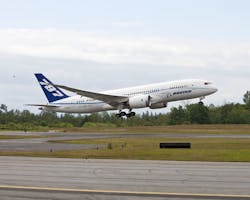Boeing, Thales, and GS Yuasa rework 787 power systems
EVERETT, Wash., 16 March 2013. Boeing (NYSE:BA) engineers have devised enhancements to the Dreamliner 787 commercial airliner’s battery system that address characteristics and factors identified by the Boeing technical team as possible causes of battery failure. An independent group of lithium-ion battery experts from a number of industries, universities, and national laboratories verified these findings, according to a company representative.
"We've come up with a comprehensive set of solutions that result in a safer battery system," says Mike Sinnett, vice president and chief project engineer, 787 program, Boeing Commercial Airplanes. "We have found a number of ways to improve the battery system and we don't let safety improvements go once they are identified. We incorporate them into our processes and products."
The first layer of improvements is taking place during the manufacture of the batteries in Japan. Boeing teamed with Thales, provider of the integrated power conversion system, and battery maker GS Yuasa to develop and institute enhanced production standards and tests to help reduce any possibility for variation in the production of the individual cells and the overall battery.
"We've all developed a better understanding of the sensitivities of this technology to variations during the manufacturing process," Sinnett explains. "And we all feel the need to increase monitoring of this process on an ongoing basis."
Four new or revised tests have been added to screen cell production, which now includes 10 distinct tests. Each cell will go through more rigorous testing in the month following its manufacture, including a 14-day test during which readings of discharge rates are being taken every hour. This new procedure started in early February and the first cells through the process are already complete. More than a dozen production acceptance tests must be completed for each battery.
Boeing, Thales, and GS Yuasa have also narrowed the acceptable level of charge for the battery, lowering the highest charge allowed and raising the lower level allowed for discharge. Two pieces of equipment in the battery system, the battery monitoring unit, and the charger are being redesigned to the narrower definition. The battery charger will also be adapted to soften the charging cycle to put less stress on the battery during charging.
Changes inside the battery will help to reduce the chances of a battery fault developing and help to further isolate any fault that does occur. To better insulate each of the cells in the battery from one another and from the battery box, two kinds of insulation will be added. An electrical insulator is being wrapped around each battery cell to electrically isolate cells from each other and from the battery case, even in the event of a failure. Electrical and thermal insulation installed above, below, and between the cells will help keep the heat of the cells from impacting each other.
Wire sleeving and the wiring inside the battery will be upgraded to be more resistant to heat and chafing and new fasteners will attach the metallic bars that connect the eight cells of the battery. These fasteners include a locking mechanism. A set of changes is being made to the battery case that contains the battery cells and the battery management unit. Small holes at the bottom will allow moisture to drain away from the battery and larger holes on the sides will allow a failed battery to vent with less impact to other parts of the battery.
The battery case will sit in a new enclosure made of stainless steel that will isolate the battery from the rest of the equipment in the electronic equipment bays. It also will ensure there can be no fire inside the enclosure, thus adding another layer of protection to the battery system. The enclosure features a direct vent to carry battery vapors outside the airplane.
New titanium fixtures are being installed in the electronics equipment bays to ensure the housing is properly supported.
"Our first lines of improvements, the manufacturing tests, and operations improvements, significantly reduce the likelihood of a battery failure. The second line of improvements, changes to the battery, helps stop an event and minimize the effect of a failure within the battery if it does occur. And the third line of improvements, the addition of the new enclosure, isolates the battery so that even if all the cells vent, there is no fire in the enclosure and there is no significant impact to the airplane," Sinnett affirms.



